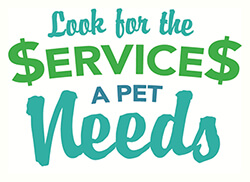
Making Money on Pet Boarding in the Veterinary Hospital
By Melanie Haber
Making money on pet boarding in a veterinary hospital is very obtainable, you just have to decide the way to target where and how the dollars are going to show up. There are many ways veterinary clinics and hospitals offer pet boarding. A few ways can include providing a safe environment for pets requiring around the clock medical care and observations. Others offer more services in one location so their clients don’t go elsewhere. And some gain income from the services that can be generated while a pet is boarding.
If your treatment room or ICU area of the practice has the space to accommodate extra cages and runs for medical boarders, this can generate a lot of income. Since this is a service that can only be provided by a qualified veterinary medical team, you are likely to get twice—if not more—boarding dollars per day than a regular boarding facility. However, these medical boarders can be a lot more work so make sure you charge appropriately for “extras” outside of the medical observation such as administering medications, checking glucose or other blood levels, bandage changes, wound cleaning, I.V. fluids services, and medical bathing.
Some pets that may not need medical attention but do poorly in a boarding environment are good candidates to board at a veterinary facility as well. Staff can monitor their feeding habits, watch for inappropriate or concerning urination activity, make an educated decision on whether a bowel movement looks normal or not, or recognize if a pet is just failing to thrive.
Next, if you have a practice that has the square–footage and employee resources to offer many pet services under one roof, this gives you huge benefits by creating a firm return visit client/veterinarian relationship. Boarding in these cases can be really lucrative if you are offering many other one–stop shop related purchases like food, retail, grooming, daycare, training, agility course, dock diving, and extended medical/surgical care like dentistry, vaccines, and wellness.

If a pet comes in for boarding, let the client know they don’t have to bring in food because you sell it there or you can let the client know their pet can be groomed the morning of departure so he is fresh and clean following his stay. Some owners feel guilty for leaving their pet so make sure you are retailing items like toys, beds, and treats that they can buy for their pet to use while boarding to alleviate their blame. If a pet shows signs of a behavior problem, offer to let the dog trainer work with the pet during their stay.
If a pet is in for daycare, let the owner know that if they want to go out for a date night, they can leave the pet overnight then be picked up at his usual time the following day. The possibilities are endless. The key is making sure you communicate your one-stop shop options to every veterinary client. Whenever a new client comes in, offer to give them a tour following their visit. Point out that you can offer daycare if their pet needs attention or socialization during the day while they are at work, boarding for extended trips, grooming services by appointment, during daycare, or while boarding. Let them know if you have facilities where the pets can get exercise indoors during the cold winter months.

Make sure you have all your offerings on your website, in a brochure, and/or listed on your business cards. You can also sweeten the loyalty by offering frequent visit cards or buy 3 services and get the 4th for free. For the ancillary services, you could create a membership package, family package or multiple pet discounts. The sky is the limit. But make sure you charge appropriately to make a profit for each department.
Finally, if you want your boarding business to provide services directly to your veterinary hospital, make sure you look for the services a pet needs. Anytime a pet comes into your boarding facility, someone qualified should take a look at each pet. This is for multiple reasons. Two of which are to make sure the pet doesn’t have any serious illness or injury upon arrival that could turn into a liability and for you to see if there are any services that the pets can have performed to save the owner a trip back to the hospital later.
While “kennel exams” that are complimentary ARE NOT a substitute for a veterinary exam, they can tell us if there is a need for the veterinarian to become involved with this pet. A simple look to see if there is ear or eye discharge, dirty teeth, lumps or bumps, abnormal urine or stools, grooming needs and other things you can see that are in obvious need of work can then result in a phone call to the client with recommendations. These recommendations can range from a simple ear cleaning to a full scale dental prophylaxis. This is the best time to get the work done, while the pet is already at the hospital under qualified staff and can recover and be back to their normal selves by the time the owners pick them up.
It is important that someone with good phone skills makes the call to the owner with the recommendations. This is a unique skill because I’ve found over the years that some vet techs feel like “used car salesmen” when they call to get a client to comply with services which create more fees. It is important that the staff understand that, while this is about making money since we do have a business to run and salaries to pay, it is primarily about being an advocate for the pet! We would never want a pet with dirty or swollen ears not to be taken care of. If we are too shy to talk about cleaning the dirty teeth, imagine how filthy and diseased the mouth will be in a year?
Plus, have the staff consider how much more it may cost and the conversation that will take place then. I would rather talk to an owner about a pet needing a routine cleaning now than about how many teeth have to be extracted and how much pain the pet has been experiencing later.

Grooming is very important, too. Groomers have an exceptional position to find even more areas that are in need of care. They can find lumps, bumps, dry skin, oily skin, and other issues which can lead to a veterinary exam. In fact, clients are more likely to take the advice of their groomer since they aren’t “out to get their money”, which gives them an edge during recommendations. Understanding this, make sure your groomers are educated or certified. Our grooming staff are required to become Certified Pet Aestheticians to give the pets the most skilled and educated staff available to work on them at all times.
If a pet has a healthy coat but gets smelly while boarding, make sure pet owners are asked if they wish to have the pet bathed before release. Make sure your staff isn’t too shy to let a client know about a $20 boarding bath. I know I feel better after a bath, doesn’t a pet deserve that too? Bottom line, veterinarians, veterinary technicians, managers, office, kennel and other staff all have a responsibility to be an advocate for the pet. Since pets can’t tell us what is wrong, it is our responsibility to check every pet in our care to see if it is in need of anything. When you are an advocate for the pet and charge appropriately for your services, the profits will follow.
If you are trying to decide whether to offer pet boarding at your veterinary facility, these are a few things to think about. The important thing to remember is decide why you want to do boarding, what type of boarding you wish to offer, and charge appropriately. Also, make sure your business is zoned for this service. Once you make the move, create a game plan to ensure all costs are covered and there is a profit. Educate your staff to be advocates for the pets, and to not feel like salesmen. Ensure they are trained to communicate all recommendations to the client then meet and exceed the expectations you are giving the client.


